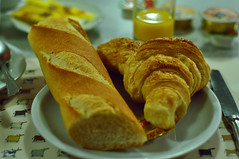![]()
![]()
![]()
Use LEFT and RIGHT arrow keys to navigate between flashcards;
Use UP and DOWN arrow keys to flip the card;
H to show hint;
A reads text to speech;
21 Cards in this Set
- Front
- Back
|
Nutrition
|
The process by which organisms receive the food and energy necessary to stay alive.
(The "My Plate" Teaches us about good nutrition) |
|
|
Nutrient
|
A substance found in our food that helps us stay alive.
(That is the first nutrient we studied) |
|
|
Fat
|
A key nutrient that provides us with energy.
(a grease spot is evidence that a food contains fat) |
|
|
Protein
|

A key nutrient that provides us with energy and help us grow and repair body tissue.
(Meats are a good source of protein) |
|
|
Carbohydrate
|

A key nutrient that provides us with energy; found in sugar and starch.
(Starch your car) (Sugar is a kind of carbohydrate, carbs give us energy) |
|
|
Sugar
|
A type of carbohydrate. Such as sucrose, fructose, and lactose.
(We used yeast as an indicator for sugar) |
|
|
Calorie
|
A measure that shows the amount of energy in food.
(Each gram of fat contains 9 calories) |
|
|
Indicator
|
A substance or material that shows the presence of a particular ingredient.
(The indicator was the brown bag) |
|
|
Yeast
|
A one-called organism belonging to the fungus kingdom.
(We used yeast as an indication for the sugar) |
|
|
Metabolism
|
A process by which an organism breaks down the food to create energy.
(Yeast needs sugar and a warm liquid for metabolism to occur) |
|
|
Chemical reaction
|
A change that occurs when two or more substances are mixed and a new substance is created as a result.
(We know a mixture of baking soda and vinegar creates a chemical reaction) |
|
|
Carbon dioxide
|
A gas found in our atmosphere.
(Carbon dioxide was the evidence for our sugar and acid test) |
|
|
Acid
|
A chemical in our food that has a sour taste.
(We tested citric fruit for acid) |
|
|
Vitamin C
|
An essential acid in human nutrition that helps heal wounds and repair tissue.
(Another name for vitamin C is ascorbic acid) |
|
|
Concentration
|
The amount of material dissolved in a liquid; the more material dissolved, the more concentrated the solution.
(Vinegar has a high concentration of acid) |
|
|
What are the parts of the food plate?
|
Protein, veggies, fruit, grains and dairy
|
|
|
Give two examples of dairy.
|
Milk and cheese
|
|
|
Give two examples of protein.
|
Pork chops and steak
|
|
|
Give two examples of grains
|
Pasta and bread
|
|
|
Give two examples of vegetables
|
Broccoli and carrots
|
|
|
Give two examples of fruit
|
Oranges and apples
|

